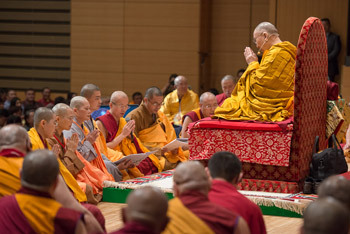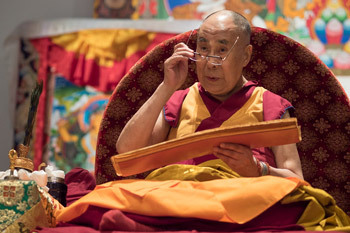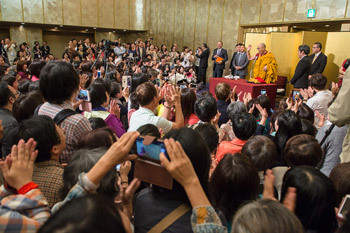Osaka, Japan, 13 May 2016 - As it was the final day of the series of teachings he has been giving in Osaka, His Holiness the Dalai Lama today met with several groups from the audience of 2700 who have attended his talks. He began by meeting a group of one thousand, mostly women, from Taiwan.
Once again he stressed the importance of studying and making good use of our intelligence. He said the best way to ensure that our education and intelligence are put to positive use is to develop a warm heart. Commenting that scientists are finding evidence that confirms that basic human nature is kind and good hearted, he suggested that if we find ways to nurture these qualities we can create a kinder more peaceful world.
“As followers of the Buddha and the Nalanda tradition, we should use what we learn to develop a calm mind and generate inner peace.
“You’re all from Taiwan,” he continued. “I’ve visited several times and been impressed by how well ordered the country is. You are heirs to ancient Chinese culture and taking an interest in Buddhism, which is very good. For political reasons I have been unable to come again recently. Ma Ying-jeou was friendly when he was Mayor of Taipei, but became more aloof once he was President. It’s understandable and I don’t want to inconvenience anyone. From my side I’m ready to come, however I don’t want to discomfit the government.”
His Holiness’s comments drew applause and many in the audience clamoured to make personal contact with him.
Back in the virtually empty teaching hall His Holiness spent 40 minutes in preparation for the Manjushri permission he was to give. The hall steadily filled as he worked through the preliminary rituals. Once he was done, a group of Japanese monks sat before him to recite the ‘Heart Sutra’ in Japanese. They were followed by a group of Chinese monks and nuns who recited the same text again in Mandarin.

|
Chinese monks and nuns reciting the Heart Sutra at the start of the final day of His Holiness the Dalai Lama's teachings in Osaka, Japan on May 13, 2016. Photo/Tenzin Choejor/OHHDL
|
His Holiness repeated the statement from the sutra that all the Buddhas of the past developed an understanding of emptiness and all the Buddhas and bodhisattvas of the future will do so too. In addition he noted the word ‘also’ in the reference to ‘looking perfectly and correctly at the emptiness of inherent existence of the five aggregates also.’ He explained that the significance of this is that the first Turning of the Wheel of Dharma only presented the selflessness of persons, whereas the second Turning of the Wheel mentioned the selflessness of phenomena as well. He noted that the statement ‘form is emptiness; emptiness is form’ confirms that form exists conventionally even though it lacks inherent existence.
His Holiness reviewed the way the Heart Sutra mantra, ‘Tadyata gate gate paragate parasamgate bodhi svaha (‘It is thus: Proceed, proceed, proceed beyond, thoroughly proceed beyond, be founded in enlightenment),’ encourages practitioners to proceed through the five paths:
gate—the path of accumulation;
gate—the path of preparation;
paragate—the path of seeing;
parasamgate—the path of meditation;
bodhi svaha—the path of no more learning.
“Today we’ll have the opportunity to take the Bodhisattva vow,” His Holiness explained and quoted a verse from Atisha’s ‘Lamp for the Path’ to show why before that he was also going to give the layperson’s vows.
Those who maintain any of the seven
Kinds of individual liberation vow,
Have the ideal for
The Bodhisattva vow, not others.
He outlined the vows not to take life, not to take what’s not given, not to tell a great lie, not to commit adultery and not to indulge in intoxicants. With regard to drinking alcohol, he told a story of Ling Rinpoche’s giving these vows and faced with an elderly Tibetan who told him he could not give up drinking altogether. He advised him that at least he should not get drunk. His Holiness also pointed out that while there is a one day vow similar to this, this vow is intended to be for life.

|
His Holiness the Dalai Lama on the final day of his teachings in Osaka, Japan on May 13, 2016. Photo/Tenzin Choejor/OHHDL
|
His Holiness duly followed the layperson’s vow with the Bodhisattva vow and followed that with the permission of Manjushri, his prayer and mantra. He said he had received it from Khunnu Lama Rinpoche, Tagdag Rinpoche, Ling Rinpoche and Trijang Rinpoche. About the prayer he recounted the story Khunnu Lama Rinpoche told him that a number of pandits in India were commissioned to write a praise to Manjushri. When each of them submitted his copy it was found that each composition was identical to the others.
After lunch, during an hour long question and answer session His Holiness explained that it was quite appropriate for Christians to study aspects of Buddhism since all religious traditions convey the same message. They all commend such qualities as love, forgiveness, tolerance, contentment and self discipline and the methods of one tradition may help the followers of another.
Asked if he had any suggestions for Taiwan, where a new President will shortly be inaugurated, His Holiness said he was not sufficiently informed about the reality on the ground to be able to offer any concrete advice. However, he stressed the importance of using human intelligence in a more positive way and how urgent it is to resolve conflict through dialogue rather than the use of force.
A question was put about whether it is better to follow only one Buddhist tradition since to take interest in many could lead to confusion. His Holiness replied that it can be helpful to learn from more than one tradition, pointing out that all Tibetan Buddhist traditions have common roots in the Nalanda tradition. He said that he had received teachings from the Nyingma masters Dilgo Khyentse Rinpoche and Trulshik Rinpoche as well as from Sakya masters. He also confirmed that he reads books from all traditions. He noted that proponents of Shugden, in warning that Gelugpas should not even touch Nyingma texts, deliberately stirred up a sectarian atmosphere. He said that although he had propitiated the spirit himself at one time, he gave it up when he realised its drawbacks.
|
A member of the audience asking a question during the final session of His Holiness the Dalai Lama's teachings in Osaka, Japan on May 13, 2016. Photo/Tenzin Choejor/OHHDL
|
He told a Mongolian student, who wanted to know why she should continue her higher education if Buddhism could teach her so much, that the Nalanda masters had no experience of computers and other technology that is useful today. He advised her to keep up her studies. Finally, he clarified that being concerned about others does not mean you forgo fulfilling your own needs, but that if you do help others there is mutual benefit.
Addressing a group of Tibetans in the audience, he thanked them for their unwavering faith. He described for them how in exile in India a Tibetan administration had been established early on and that it followed a democratic model. The steady progress of democracy meant that he had been able to semi-retire in 2001 and to fully retire in 2011 devolving his political responsibility to the elected leadership. He stressed that his retirement did not reflect any sense of discouragement and that he eagerly continues to talk about and work for the preservation of Tibetan language and culture as well as its natural environment.
He observed that when the Dalai Lama was in Tibet hardly anyone could see him, whereas now he can travel almost anywhere in the world and he has friends everywhere.
“I’m not shy,” he said. “We Tibetans are sharp. I am from Domey like Je Tsongkhapa and I have a sharp mind too. Although I was quite lazy about my studies when I was young, the education and training I received in Tibet has equipped me to engage in fulfilling conversations with modern scientists over the last more than thirty years.
|
His Holiness the Dalai Lama speaking during the final session of his teachings in Osaka, Japan on May 13, 2016.
Photo/Tenzin Choejor/OHHDL
|
“People used to dismiss Tibetan Buddhism as Lamaism as if it was not an authentic Buddhist tradition. Now we declare that it is the heir of the Nalanda tradition and is the most comprehensive Buddhist tradition in the world today. In addition to studying classic treatises like Nagarjuna’s ‘Fundamental Wisdom’ and Maitreya’s ‘Ornament for Clear Realization’, we have translations of all seven of Dharmakirti’s works on logic and epistemology. We not only have translations of these books, we have a living command of their contents.
“Recently, when I was receiving medical treatment in the US I heard that many Tibetans gathered to pray for me. I’d like to thank you and reassure you that I feel well. You don’t need to worry about me. Truth will prevail. China is changing. We will be together again. For now, study what you can. Improve your education and otherwise take things easily.”
Talking separately to some Chinese, His Holiness observed that wherever they are in the world, Chinese people preserve their identity and work hard. He said a sign of how China had changed over the last 40 years was the number of people who are again showing an interest in religion. Now China has the largest Buddhist population in the world. As popular interests change the system will have to change too. He recalled that President Xi Jinping two years ago in Paris had clearly mentioned the important contribution Buddhism had to make to Chinese culture. He repeated it in Delhi, an unexpected remark from the leader of the Chinese Communist Party.
“I’ve lived the greater part of my life in exile,” he told them, “but my health and energy are still good. I’m nearly 81 now. If I live to be 90 or 100 I hope still to be of some service to China and the Chinese people. Please keep this in mind
|
His Holiness the Dalai Lama speaking to a group of Chinese after the final day of his teachings in Osaka, Japan on May 13, 2016. Photo/Tenzin Choejor/OHHDL
|
“I meet with quite a few Chinese these days. A few years ago I met with a group that included a poor farmer. I asked him about circumstances in his village. He told me things were very difficult, that there was a huge gap between rich and poor. Those of you who are now better off should try to help those in need. For example, I’m quite worried about education in remote parts of the country. Meanwhile, Xi Jinping is trying to tackle corruption, but it is a big challenge.”
In answering questions from this group His Holiness emphasised the importance of the monastic community, repeating the Buddha’s advice that where the Vinaya is observed the Dharma will flourish. He mentioned that there are aspects of Buddhist science and philosophy, such as its understanding of the workings of the mind and emotions, as well as the view of dependent origination, that may be helpful even to those not interested in Buddhism.
He was challenged about Tibetan Buddhism’s attitude to eating meat. He responded that there are clear guidelines about this, but that since Buddhist monks traditionally gathered alms, they had to accept whatever they were given. He told the story of his own attempt to live as a vegetarian and his falling ill with jaundice. His physicians advised him to eat some meat again, so he does so a couple of times a week. Nevertheless, while still in Tibet he stopped the lavish use of meat in official banquets and has since encouraged monastery kitchens in exile to stop preparing it. He laughed while admitting that he encourages others to be vegetarian, but is unable to be so himself.
He reiterated the importance of education and that since he tells Tibetans that reciting 'Manis' is not enough, he feels he should also tell Chinese that prayers to Amitabha are not enough either. He concluded by saying that in his own practice it’s his effort to understand emptiness and realize the awakening mind that really makes a difference.
Tomorrow, His Holiness will leave Osaka for Narita, where he will board a flight that will take him back to India.



